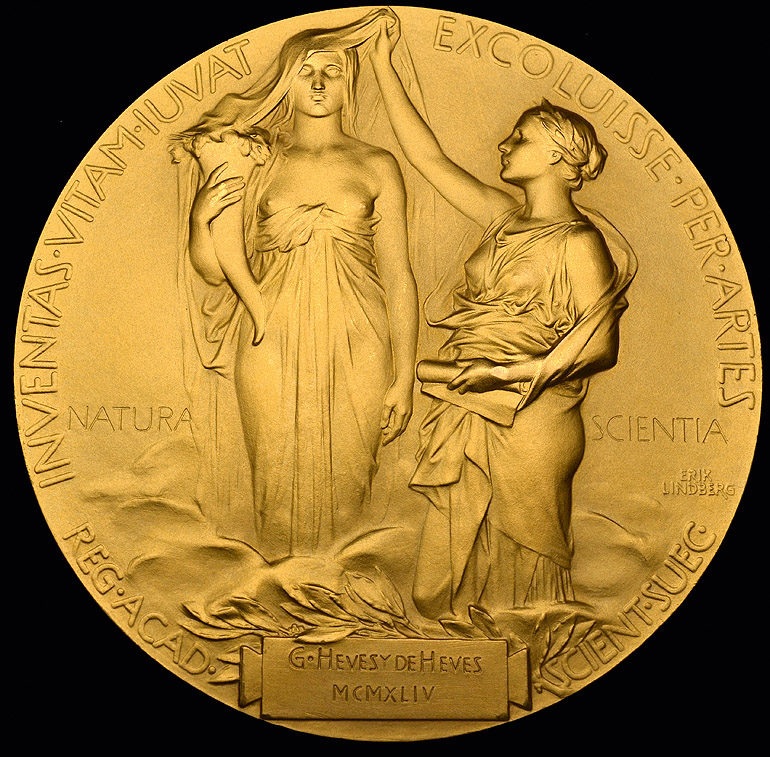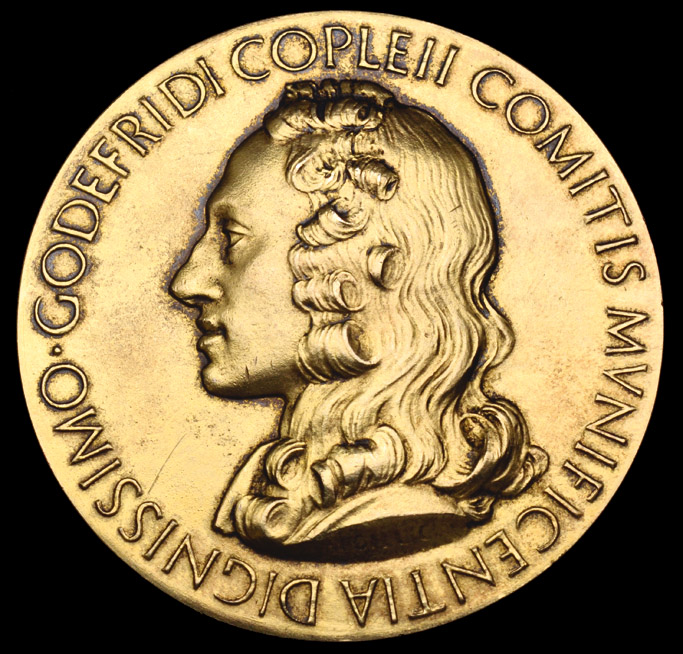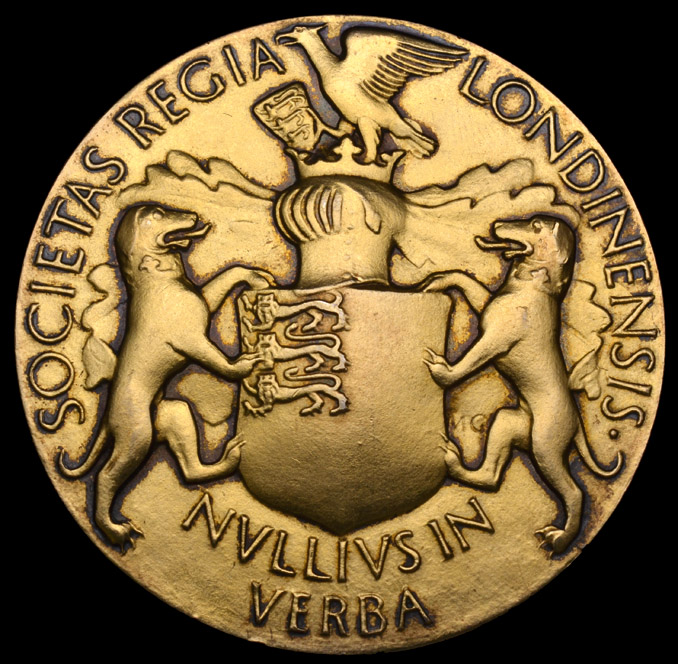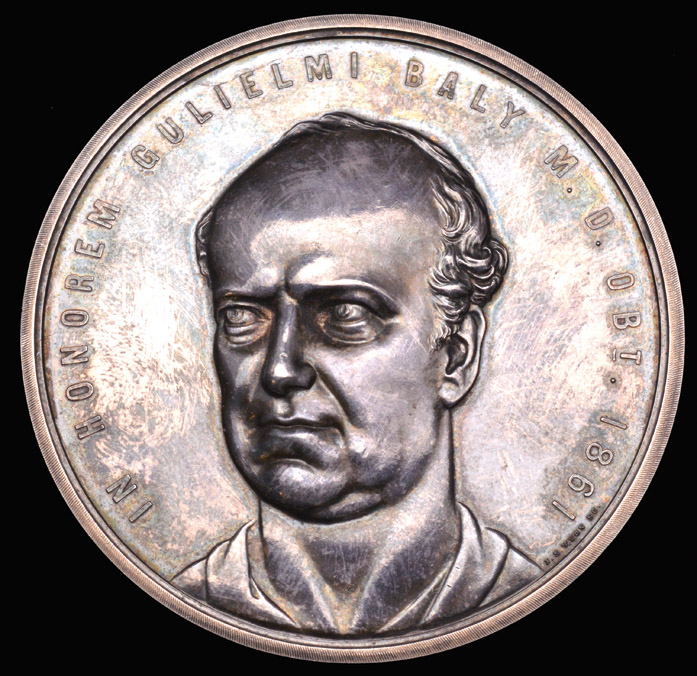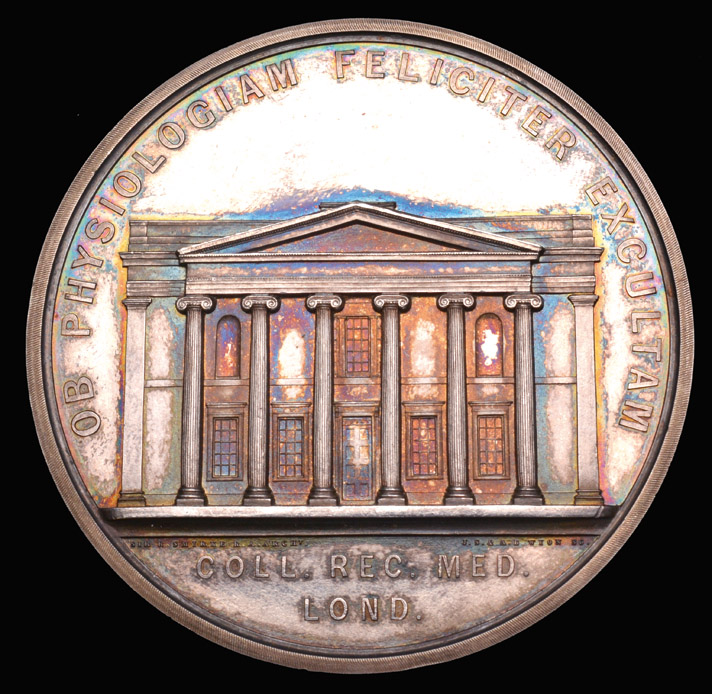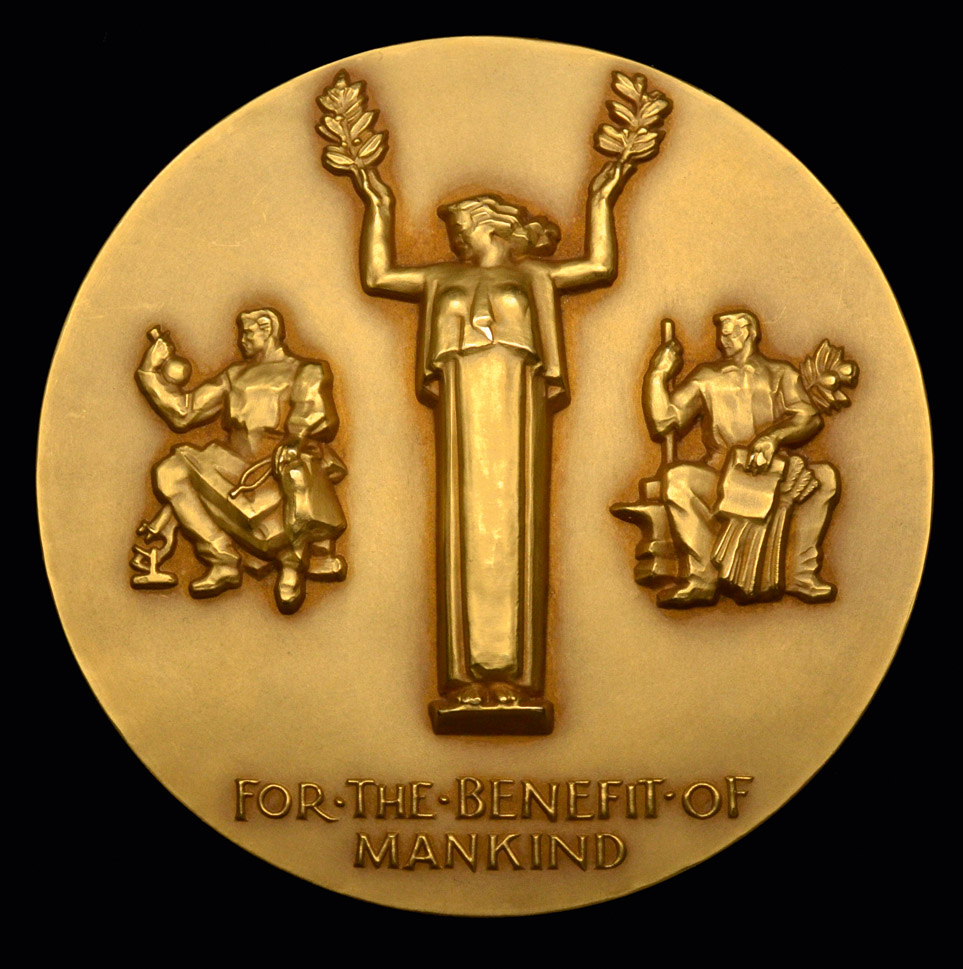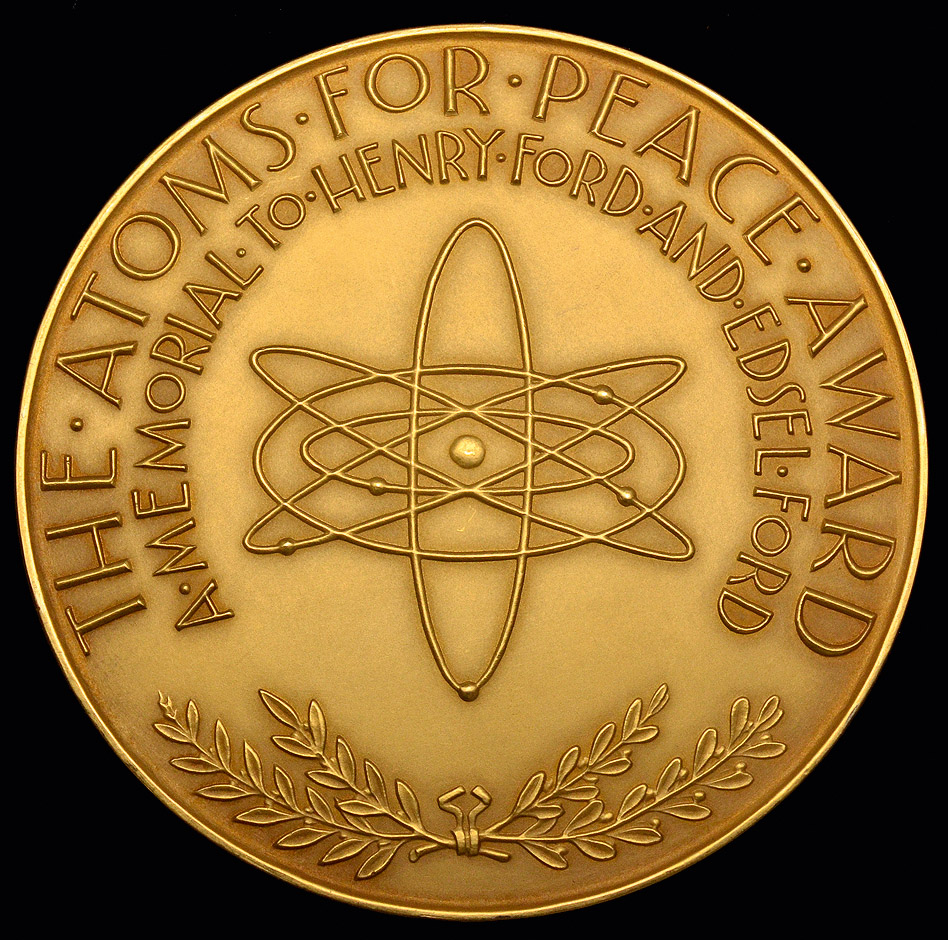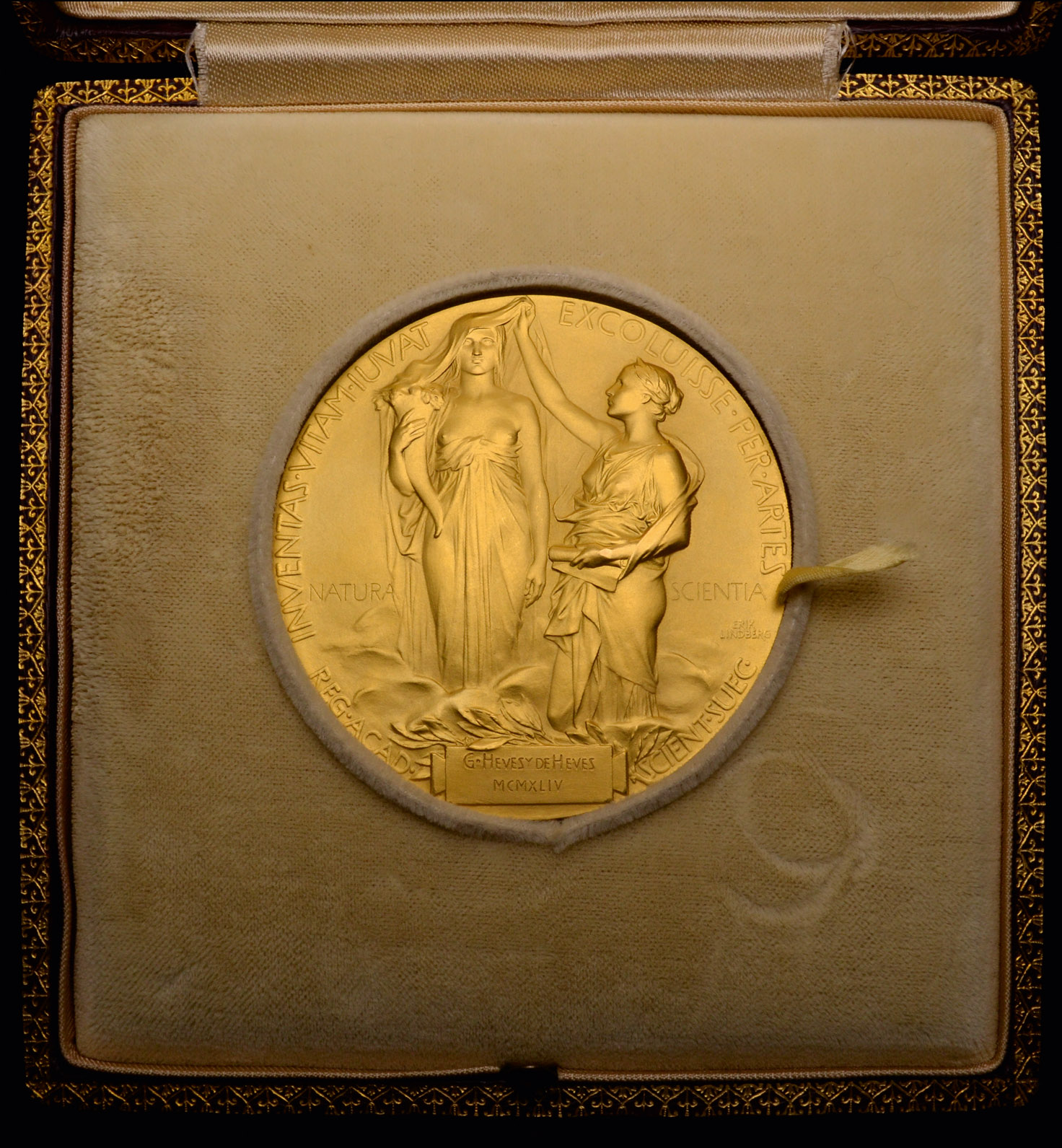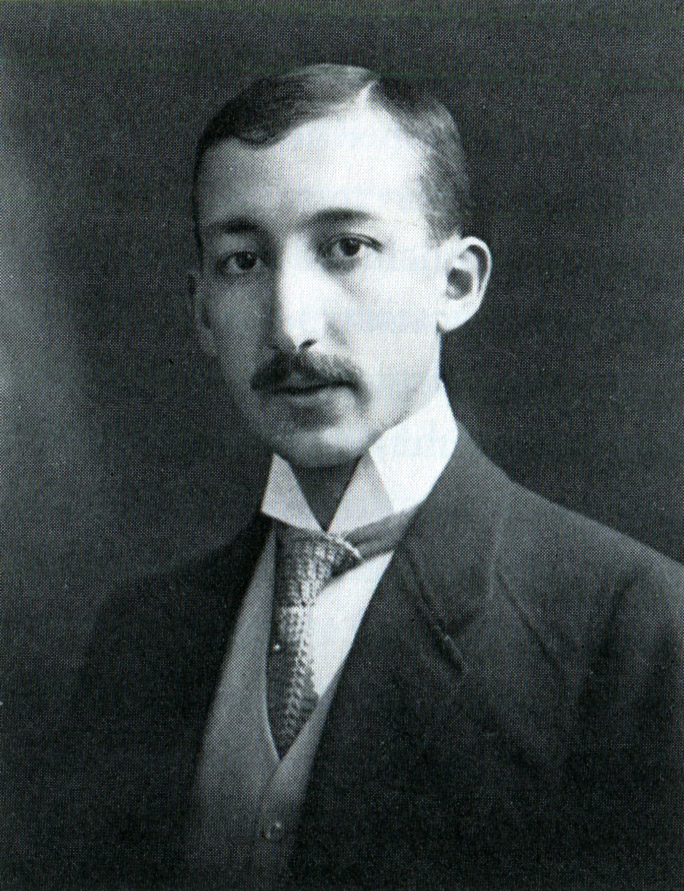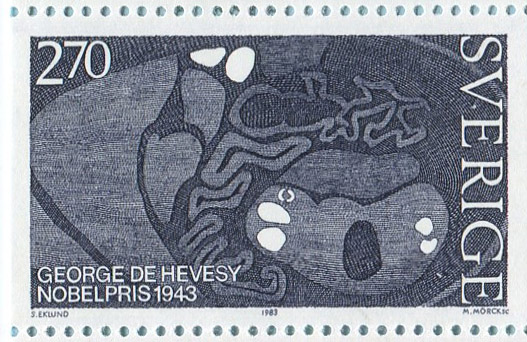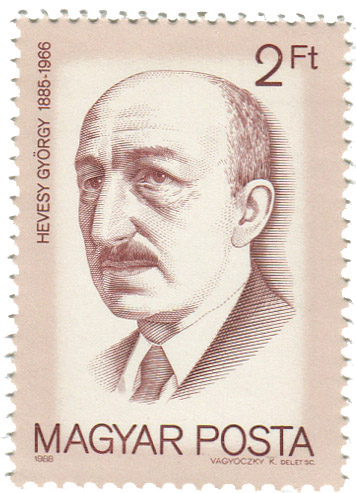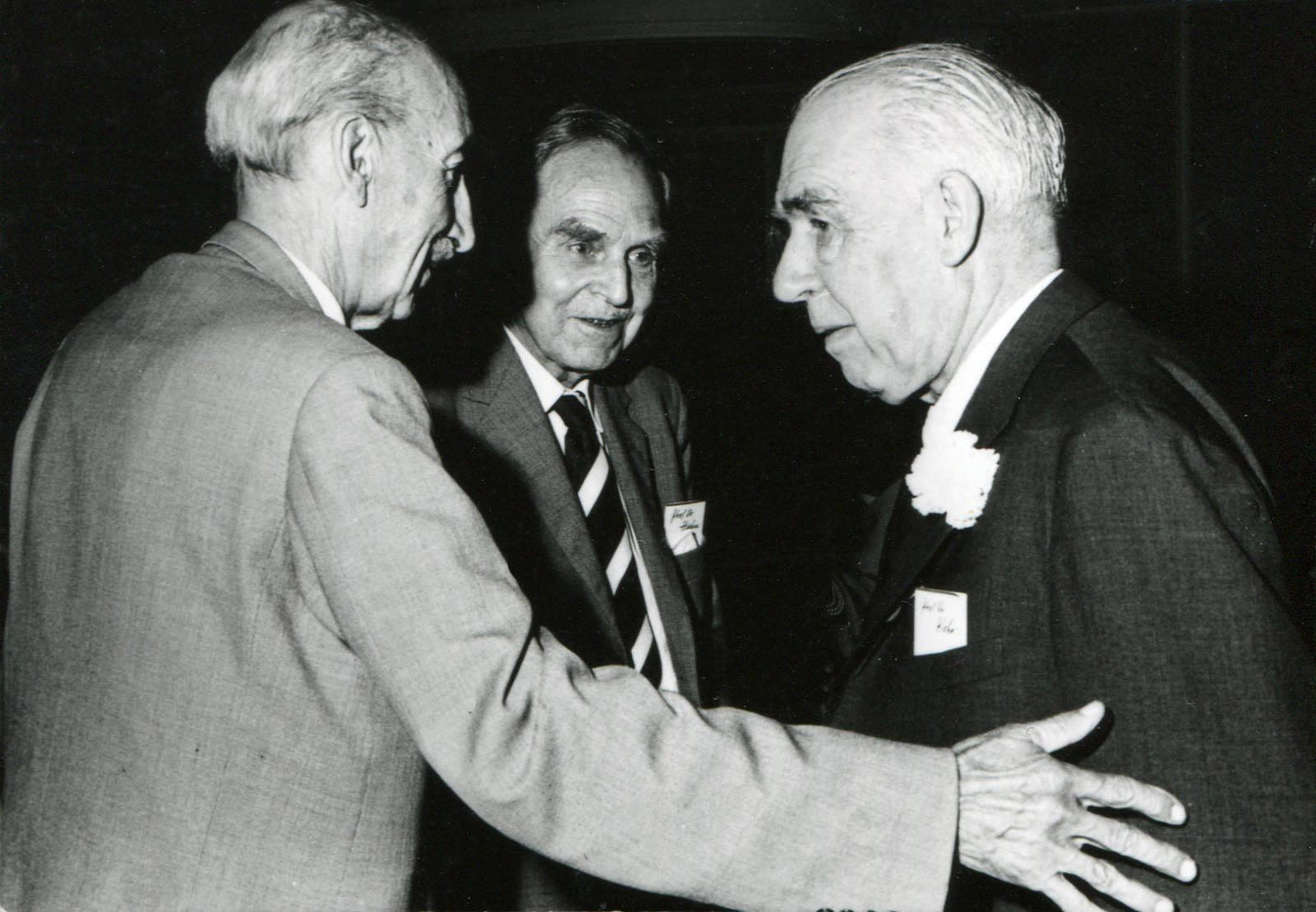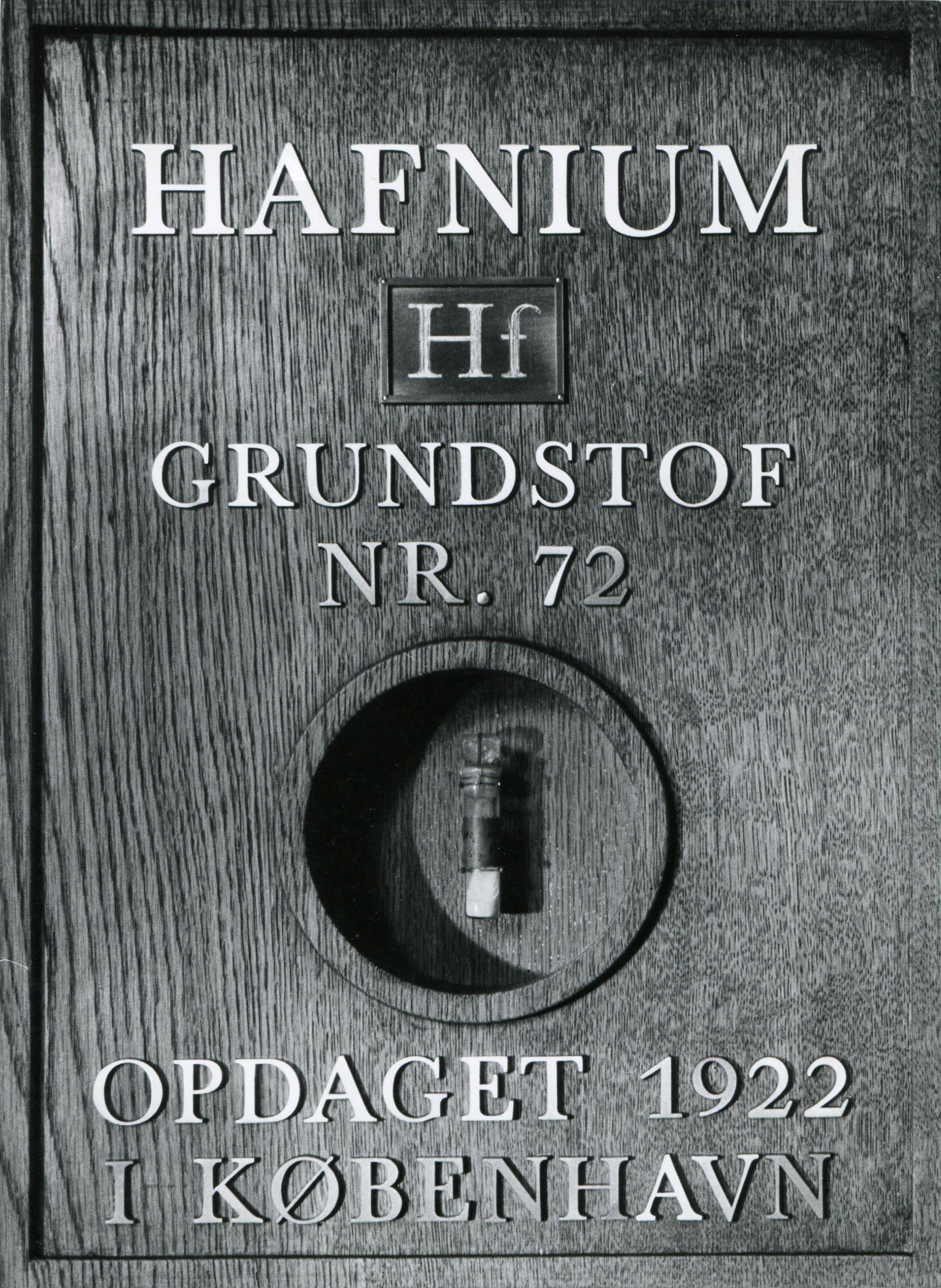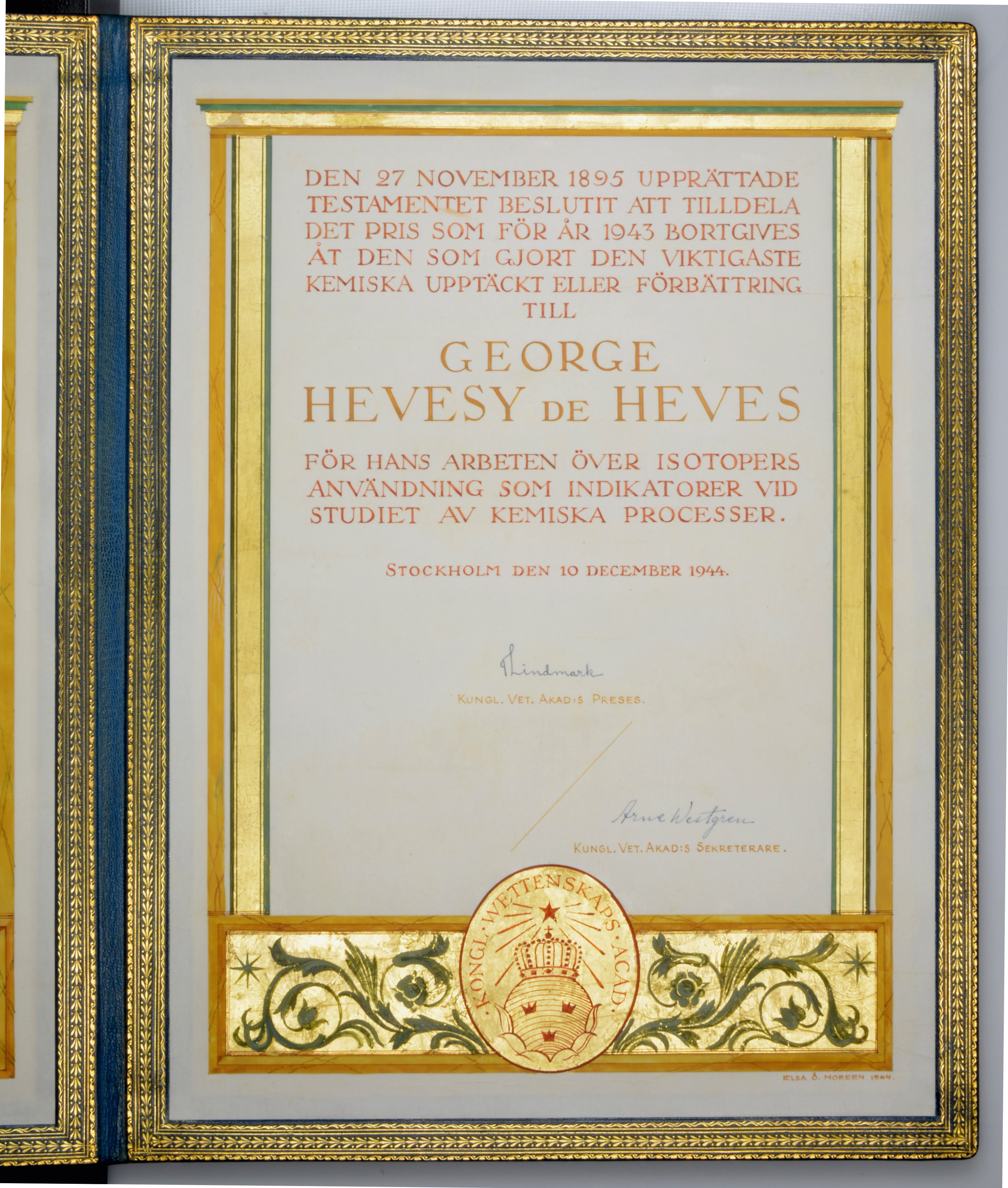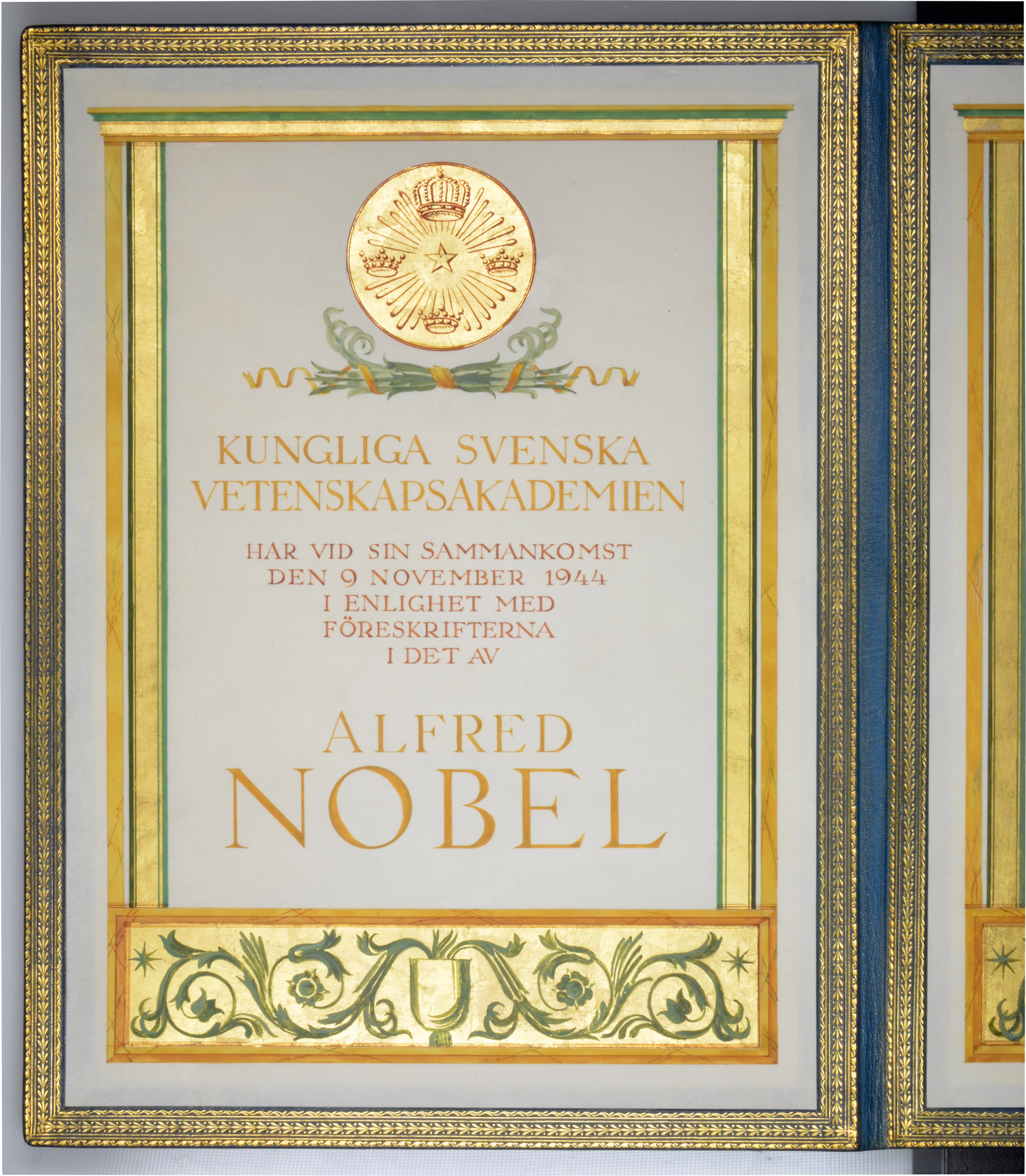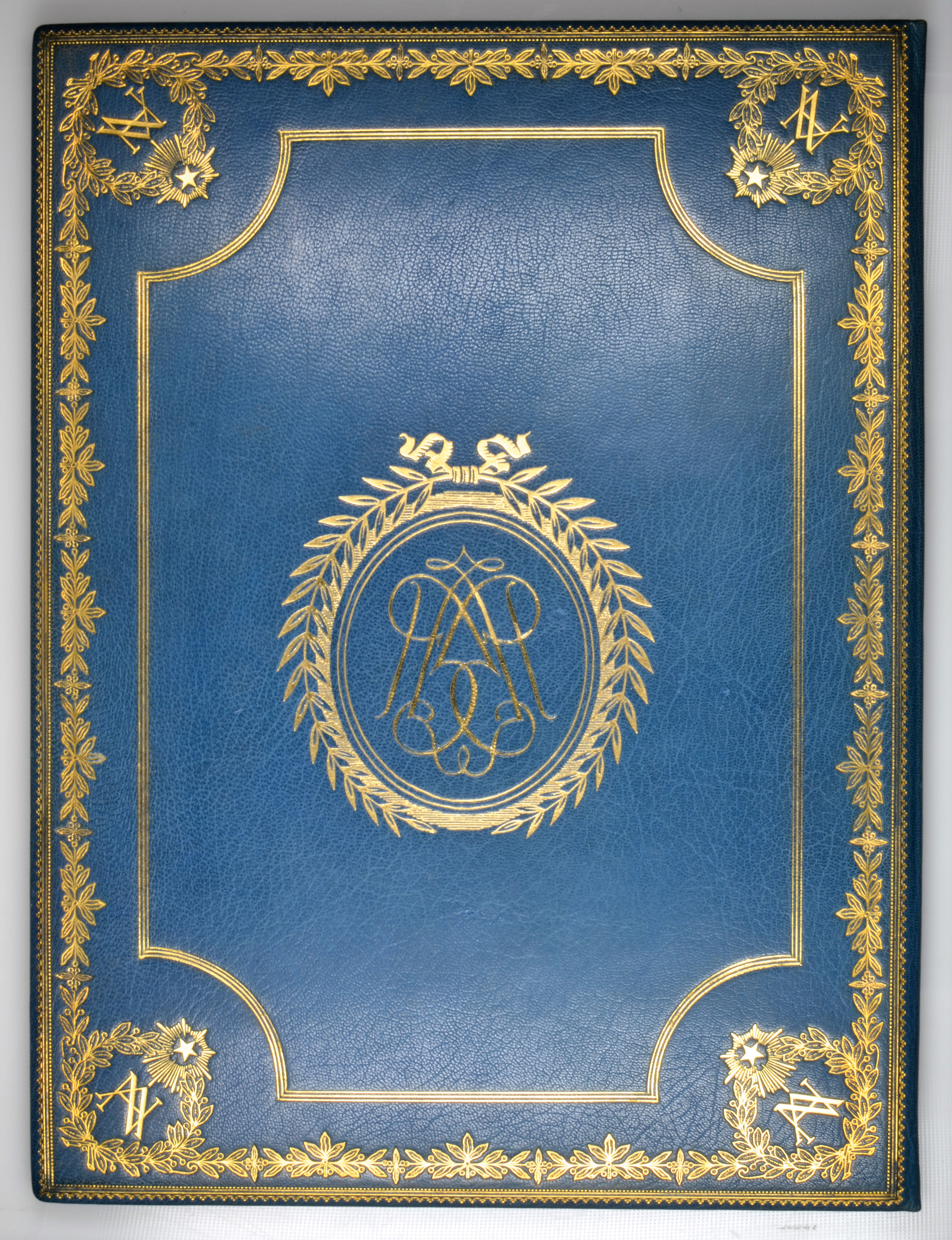77
The Nobel Prize in Chemistry and three further medals awarded to George de Hevesy (1885-1966),
joint discoverer of the element Hafnium in 1922, developer of the use of radioactive isotopes as tracers and who, in 1940, famously dissolved the Nobel Medals which had been awarded to Max von Laue and James Franck to conceal them from the Nazis, comprising: (i) Nobel Medal for Chemistry, in 23 carat gold, by Erik Lindberg, obv., bust of Alfred Nobel left, rev., inventas vitam iuvat excoluisse per artes, allegorical figures of Science holding scroll unveiling Nature holding cornucopia, reg. acad. scient. suec. below, divided by panel engraved G. Hevesy de Heves mcmxliv, edge marked guld and dated 1944, 66mm, 207.75g, light handling marks, otherwise virtually as struck, in its fitted display case of issue [this slightly waterstained]; (ii) Royal Society’s Copley Medal, in silver-gilt, by Mary Gillick, awarded in 1949, edge engraved professor george charles de hevesy. for. mem. r.s., 56.8mm, good extremely fine; (iii) Royal College of Physicians’ Baly Medal, in silver, by J.S. and A.B. Wyon, edge engraved george de hevesy. 1951, 58mm, virtually as struck, well toned; (iv) Atoms for Peace Award, large gold medal, struck in high relief by Medallic Art Co., New York, edge engraved george charles de hevesy. 1958, 18 ct. fine, 302.8g, very minor traces of handling, virtually as struck. The lot is offered with: The Nobel Institute’s individually-prepared gilt blue leather casebound presentation folder containing the illustrated manuscript citation for the award to George de Hevesy (this signed ELSA Ö NOREEN, 1944), in original lined and padded box, in perfect condition as awarded; A Nobel Institute dinner menu, 1946; An original folder and Press Release including the citation for the Atoms For Peace award, with text of the address by Dag Hammarskjold, U.N. Secretary-General, 1959, and original embossed card from the presentation; Several photographs, copy documentation and related items (lot). The Nobel Prize in Chemistry was awarded to George de Hevesy in 1943, with the citation reading: ‘For his work on the use of isotopes as tracers in the study of chemical processes’. The Prize was reserved until the following year and de Hevesy therefore received it in 1944. The Copley Medal was awarded to de Hevesy in 1949 ‘For his distinguished work on the chemistry of radioactive elements and especially for his development of the radioactive tracer techniques in the investigation of biological processes’. De Hevesy had been elected as a Foreign Member of the Royal Society in 1939 and felt himself to be especially honoured by the award of its Copley Medal. The Baly Medal has been awarded biannually since 1869 by the Council and President of the Royal College of Physicians to a person who has especially distinguished themselves in the study of physiology. The award was established in memory of William Baly, whose valuable work on hygiene in prisons was cut short by his death in a railway accident. The Atoms for Peace Award was established following a grant of $1,000,000 made by the Ford Motor Company in direct response to President Dwight D. Eisenhower’s celebrated 1953 ‘Atoms for Peace’ speech to the United Nations General Assembly. The first recipient, in 1957, was George de Hevesy’s close friend and colleague Niels Bohr, de Hevesy himself being honoured in the following year. The award was made only 23 times in total, the last recipient being Eisenhower himself in 1969. George Charles de Hevesy was born in Budapest in 1885 into a prominent Hungarian family of Jewish descent. Hevesy’s studies took him to Berlin, Freiburg, Zürich, and Karlsruhe before travelling to Manchester, in January 1911, to work under Ernest Rutherford on research into radioactivity. One day Hevesy met Rutherford in the cellar of the Institute where some hundred kilograms of lead in pitchblende was stored. Rutherford remarked ‘if you are worth your salt my boy try to separate the radium-D from all that nuisance of lead’. In spite of his best efforts, Hevesy failed – but the process did show him that if radium-D could not be separated from lead there remains a ‘marker’ (or tracer), and this realisation was to profoundly affect his future work. In 1912 Niels Bohr also arrived in Manchester and the two men at once formed a close friendship and professional association which was to last a lifetime. Hevesy also met Einstein in Vienna and, in the winter of 1913-14, he returned to the University of Budapest before the outbreak of war. An unenthusiastic recruit to the Austro-Hungarian army and never physically strong, Hevesy was soon transferred to civil duties in 1915, including the unpleasant task of melting church bells to provide metal for armaments. Although pursuing his work as far as he could during this period the effects of war, including a growing sense of anti-Semitism in Budapest, meant that Hevesy was keen to accept an invitation to join Niels Bohr’s new Institute in Copenhagen as soon as possible after hostilities ended. With Bohr’s support, and working with Dutch researcher Dirk Coster, Hevesy finally succeeded in isolating the element numbered 72 in the periodic table. By chance the breakthrough came whilst Niels Bohr was in Stockholm to receive his own Nobel prize in late 1922 and the element, which absorbs neutrons with very high efficiency, was named Hafnium (after ‘Hafnia’ the Latin name for Copenhagen). In 1924 Hevesy married Pia Riis in Denmark and in 1927 the couple moved to Freiburg im Breisgau, where Hevesy accepted a Professorship. His work and growing reputation took him all over the world but by the mid-1930s it became apparent that he could not remain in Nazi Germany so the Hevesys moved again, returning to Copenhagen and the Bohr Institute. Other scientists associated with the Institute included the German physicists Max von Laue and James Franck, Nobel laureates in 1914 and 1925 respectively. Their named Nobel medals were stored at the Bohr Institute for safe keeping outside Germany, where the Nazi Government had introduced draconian regulations regarding personal holding of gold. Contravention of these rules ran a real risk of incurring the death penalty and in the early summer of 1940, as Denmark was being invaded and occupied, the Institute had to decide what to do with the potentially incriminating medals. Bohr had already sold his own award to raise funds for relief in Finland but the risk of discovery of the other two was very real. After rejecting the idea of burying the awards, Hevesy removed the evidence by dissolving them in aqua regia, leaving the resulting solution on a shelf in a flask which, fortunately, did not arouse suspicion. After the war the flask was still there and undisturbed; Hevesy was able to recover the gold by reversing the chemical process. He returned the reconstituted metal to the Nobel Foundation and it was duly used to make restrikes of the two medals which were re-awarded to both their original recipients in 1952! During the war Hevesy himself was honoured with his own Nobel Prize in 1944, in recognition of a lifetime’s work, and also accepted the offer, available to all Nobel Laureates, of Swedish citizenship. The official citation for his prize used the now-familiar terms ‘isotopes’ and ‘tracers’ which had not even been coined when his work began. George de Hevesy’s work and achievements have led, in particular, to enormous advances in radiobiology, medical research and clinical diagnosis, including XRF analysis. He has been called the founder of radioanalytical chemistry and, in addition to the medals offered here, he was recognised with many further accolades and honours during his lifetime. These include that of becoming the third Niels Bohr Medallist in 1961 (following the awards to his great friend Niels Bohr himself (in 1955) and to Sir John Cockroft (in 1958)).
joint discoverer of the element Hafnium in 1922, developer of the use of radioactive isotopes as tracers and who, in 1940, famously dissolved the Nobel Medals which had been awarded to Max von Laue and James Franck to conceal them from the Nazis, comprising: (i) Nobel Medal for Chemistry, in 23 carat gold, by Erik Lindberg, obv., bust of Alfred Nobel left, rev., inventas vitam iuvat excoluisse per artes, allegorical figures of Science holding scroll unveiling Nature holding cornucopia, reg. acad. scient. suec. below, divided by panel engraved G. Hevesy de Heves mcmxliv, edge marked guld and dated 1944, 66mm, 207.75g, light handling marks, otherwise virtually as struck, in its fitted display case of issue [this slightly waterstained]; (ii) Royal Society’s Copley Medal, in silver-gilt, by Mary Gillick, awarded in 1949, edge engraved professor george charles de hevesy. for. mem. r.s., 56.8mm, good extremely fine; (iii) Royal College of Physicians’ Baly Medal, in silver, by J.S. and A.B. Wyon, edge engraved george de hevesy. 1951, 58mm, virtually as struck, well toned; (iv) Atoms for Peace Award, large gold medal, struck in high relief by Medallic Art Co., New York, edge engraved george charles de hevesy. 1958, 18 ct. fine, 302.8g, very minor traces of handling, virtually as struck. The lot is offered with: The Nobel Institute’s individually-prepared gilt blue leather casebound presentation folder containing the illustrated manuscript citation for the award to George de Hevesy (this signed ELSA Ö NOREEN, 1944), in original lined and padded box, in perfect condition as awarded; A Nobel Institute dinner menu, 1946; An original folder and Press Release including the citation for the Atoms For Peace award, with text of the address by Dag Hammarskjold, U.N. Secretary-General, 1959, and original embossed card from the presentation; Several photographs, copy documentation and related items (lot). The Nobel Prize in Chemistry was awarded to George de Hevesy in 1943, with the citation reading: ‘For his work on the use of isotopes as tracers in the study of chemical processes’. The Prize was reserved until the following year and de Hevesy therefore received it in 1944. The Copley Medal was awarded to de Hevesy in 1949 ‘For his distinguished work on the chemistry of radioactive elements and especially for his development of the radioactive tracer techniques in the investigation of biological processes’. De Hevesy had been elected as a Foreign Member of the Royal Society in 1939 and felt himself to be especially honoured by the award of its Copley Medal. The Baly Medal has been awarded biannually since 1869 by the Council and President of the Royal College of Physicians to a person who has especially distinguished themselves in the study of physiology. The award was established in memory of William Baly, whose valuable work on hygiene in prisons was cut short by his death in a railway accident. The Atoms for Peace Award was established following a grant of $1,000,000 made by the Ford Motor Company in direct response to President Dwight D. Eisenhower’s celebrated 1953 ‘Atoms for Peace’ speech to the United Nations General Assembly. The first recipient, in 1957, was George de Hevesy’s close friend and colleague Niels Bohr, de Hevesy himself being honoured in the following year. The award was made only 23 times in total, the last recipient being Eisenhower himself in 1969. George Charles de Hevesy was born in Budapest in 1885 into a prominent Hungarian family of Jewish descent. Hevesy’s studies took him to Berlin, Freiburg, Zürich, and Karlsruhe before travelling to Manchester, in January 1911, to work under Ernest Rutherford on research into radioactivity. One day Hevesy met Rutherford in the cellar of the Institute where some hundred kilograms of lead in pitchblende was stored. Rutherford remarked ‘if you are worth your salt my boy try to separate the radium-D from all that nuisance of lead’. In spite of his best efforts, Hevesy failed – but the process did show him that if radium-D could not be separated from lead there remains a ‘marker’ (or tracer), and this realisation was to profoundly affect his future work. In 1912 Niels Bohr also arrived in Manchester and the two men at once formed a close friendship and professional association which was to last a lifetime. Hevesy also met Einstein in Vienna and, in the winter of 1913-14, he returned to the University of Budapest before the outbreak of war. An unenthusiastic recruit to the Austro-Hungarian army and never physically strong, Hevesy was soon transferred to civil duties in 1915, including the unpleasant task of melting church bells to provide metal for armaments. Although pursuing his work as far as he could during this period the effects of war, including a growing sense of anti-Semitism in Budapest, meant that Hevesy was keen to accept an invitation to join Niels Bohr’s new Institute in Copenhagen as soon as possible after hostilities ended. With Bohr’s support, and working with Dutch researcher Dirk Coster, Hevesy finally succeeded in isolating the element numbered 72 in the periodic table. By chance the breakthrough came whilst Niels Bohr was in Stockholm to receive his own Nobel prize in late 1922 and the element, which absorbs neutrons with very high efficiency, was named Hafnium (after ‘Hafnia’ the Latin name for Copenhagen). In 1924 Hevesy married Pia Riis in Denmark and in 1927 the couple moved to Freiburg im Breisgau, where Hevesy accepted a Professorship. His work and growing reputation took him all over the world but by the mid-1930s it became apparent that he could not remain in Nazi Germany so the Hevesys moved again, returning to Copenhagen and the Bohr Institute. Other scientists associated with the Institute included the German physicists Max von Laue and James Franck, Nobel laureates in 1914 and 1925 respectively. Their named Nobel medals were stored at the Bohr Institute for safe keeping outside Germany, where the Nazi Government had introduced draconian regulations regarding personal holding of gold. Contravention of these rules ran a real risk of incurring the death penalty and in the early summer of 1940, as Denmark was being invaded and occupied, the Institute had to decide what to do with the potentially incriminating medals. Bohr had already sold his own award to raise funds for relief in Finland but the risk of discovery of the other two was very real. After rejecting the idea of burying the awards, Hevesy removed the evidence by dissolving them in aqua regia, leaving the resulting solution on a shelf in a flask which, fortunately, did not arouse suspicion. After the war the flask was still there and undisturbed; Hevesy was able to recover the gold by reversing the chemical process. He returned the reconstituted metal to the Nobel Foundation and it was duly used to make restrikes of the two medals which were re-awarded to both their original recipients in 1952! During the war Hevesy himself was honoured with his own Nobel Prize in 1944, in recognition of a lifetime’s work, and also accepted the offer, available to all Nobel Laureates, of Swedish citizenship. The official citation for his prize used the now-familiar terms ‘isotopes’ and ‘tracers’ which had not even been coined when his work began. George de Hevesy’s work and achievements have led, in particular, to enormous advances in radiobiology, medical research and clinical diagnosis, including XRF analysis. He has been called the founder of radioanalytical chemistry and, in addition to the medals offered here, he was recognised with many further accolades and honours during his lifetime. These include that of becoming the third Niels Bohr Medallist in 1961 (following the awards to his great friend Niels Bohr himself (in 1955) and to Sir John Cockroft (in 1958)).
War Medals, Orders and Decorations
Sale Date(s)
Venue Address
For Morton & Eden Ltd. delivery information please telephone +44 (0)20 7493 5344.
Important Information
Auction venue:
Sotheby's, in the Lower Grosvenor Gallery
The Aeolian Hall, Bloomfield Place
London W1A 2AA
Public viewing at:
Nash House
St George Street
London W1S 2FQ
Terms & Conditions
Conditions of Business for Buyers
1. Introduction
(a) The contractual relationship of Morton & Eden Ltd. and Sellers with prospective Buyers is governed by:-
(i) these Conditions of Business for Buyers;
(ii) the Conditions of Business for Sellers displayed in the saleroom and available from Morton & Eden Ltd.; (iii) Morton & Eden Ltd.’s Authenticity Guarantee;
(iv) any additional notices and terms printed in the sale catalogue, in each case as amended by any saleroom notice or auctioneer's announcement.
(b) As auctioneer, Morton & Eden Ltd. acts as agent for the Seller. Occasionally, Morton & Eden Ltd. may own or have a financial interest in a lot.
2. Definitions "Bidder" is any person making, attempting or considering making a bid, including Buyers;
"Buyer" is the person who makes the highest bid or offer accepted by the auctioneer, including a Buyer’s principal when bidding as agent;
"Seller" is the person offering a lot for sale, including their agent, or executors;
“M&E” means Morton & Eden Ltd., auctioneers, 45 Maddox Street, London W1S 2PE, company number 4198353.
"Buyer’s Expenses" are any costs or expenses due to Morton & Eden Ltd. from the Buyer; "Buyer’s Premium" is the commission payable by the Buyer on the Hammer Price at the rates set out in the Important Information for Buyers;
"Hammer Price" is the highest bid for the Property accepted by the auctioneer at the auction or the post auction sale price;
"Purchase Price" is the Hammer Price plus applicable Buyer’s Premium and Buyer’s Expenses;
"Reserve Price" (where applicable) is the minimum Hammer Price at which the Seller has agreed to sell a lot.
The Buyer’s Premium, Buyer’s Expenses and Hammer Price are subject to VAT, where applicable.
3. Examination of Lots (a) M&E’s knowledge of lots is partly dependent on information provided by the Seller and M&E is unable to exercise exhaustive due diligence on each lot. Each lot is available for examination before sale. Bidders are responsible for carrying out examinations and research before sale to satisfy themselves over the condition of lots and accuracy of descriptions.
(b) All oral and/or written information provided to Bidders relating to lots, including descriptions in the catalogue, condition reports or elsewhere are statements of M&E’s opinion and not representations of fact. Estimates may not be relied on as a prediction of the selling price or value of the lot and may be revised from time to time at M&E’s absolute discretion.
4. Exclusions and limitations of liability to Buyers
(a) M&E shall refund the Purchase Price to the Buyer in circumstances where it deems that the lot is a Counterfeit, subject to the terms of M&E’s Authenticity Guarantee.
(b) Subject to Condition 4(a), neither M&E nor the Seller:-
(i) is liable for any errors or omissions in any oral or written information provided to Bidders by M&E, whether negligent or otherwise;
(ii) gives any guarantee or warranty to Bidders and any implied warranties and conditions are excluded (save in so far as such obligations cannot be excluded by English law), other than the express warranties given by the Seller to the Buyer (for which the Seller is solely responsible) under the Conditions of Business for Sellers;
(iii) accepts responsibility to Bidders for acts or omissions (whether negligent or otherwise) by M&E in connection with the conduct of auctions or for any matter relating to the sale of any lot.
(c) Without prejudice to Condition 4(b), any claim against M&E and/ or the Seller by a Bidder is limited to the Purchase Price for the relevant lot. Neither M&E nor the Seller shall be liable for any indirect or consequential losses.
(d) Nothing in Condition 4 shall exclude or limit the liability of M&E or the Seller for death or personal injury caused by the negligent acts or omissions of M&E or the Seller.
5. Bidding at Auction
(a) M&E has absolute discretion to refuse admission to the auction. Before sale, Bidders must complete a Registration Form and supply such information and references as M&E requires. Bidders are personally liable for their bid and are jointly and severally liable with their principal, if bidding as agent (in which case M&E’s prior and express consent must be obtained).
(b) M&E advises Bidders to attend the auction, but M&E will endeavour to execute absentee written bids provided that they are, in M&E’s opinion, received in sufficient time and in legible form.
(c) When available, written and telephone bidding is offered as a free service at the Bidder’s risk and subject to M&E’s other commitments; M&E is therefore not liable for failure to execute such bids. Telephone bidding may be recorded.
6. Import, Export and Copyright Restrictions M&E and the Seller make no representations or warranties as to whether any lot is subject to import, export or copyright restrictions. It is the Buyer's sole responsibility to obtain any copyright clearance or any necessary import, export or other licence required by law, including licenses required under the Convention on the International Trade in Endangered Species (CITES).
7. Conduct of the Auction
(a) The auctioneer has discretion to refuse bids, withdraw or re-offer lots for sale (including after the fall of the hammer) if (s)he believes that there may be an error or dispute, and may also take such other action as (s)he reasonably deems necessary.
(b) The auctioneer will commence and advance the bidding in such increments as (s)he considers appropriate and is entitled to place bids on the Seller’s behalf up to the Reserve Price for the lot, where applicable.
(c) Subject to Condition 7(a), the contract between the Buyer and the Seller is concluded on the striking of the auctioneer's hammer.
(d) Any post-auction sale of lots shall incorporate these Conditions of Business.
8. Payment and Collection
(a) Unless otherwise agreed in advance, payment of the Purchase Price is due in pounds sterling immediately after the auction (the "Payment Date").
(b) Title in a lot will not pass to the Buyer until M&E has received the Purchase Price in cleared funds. M&E will generally not release a lot to a Buyer before payment. Earlier release shall not affect passing of title or the Buyer's obligation to pay the Purchase Price, as above.
(c) The refusal of any licence or permit required by law, as outlined in Condition 6, shall not affect the Buyer’s obligation to pay for the lot, as per Condition 8(a).
(d) The Buyer must arrange collection of lots within 10 working days of the auction. Purchased lots are at the Buyer's risk from the earlier of (i) collection or (ii) 10 working days after the auction. Until risk passes, M&E will compensate the Buyer for any loss or damage to the lot up to a maximum of the Purchase Price actually paid by the Buyer. M&E’s assumption of risk is subject to the exclusions detailed in Condition 5(d) of the Conditions of Business for Sellers.
(e) All packing and handling of lots is at the Buyer's risk. M&E will not be liable for any acts or omissions of third party packers or shippers.
9. Remedies for non-payment Without prejudice to any rights that the Seller may have, if the Buyer without prior agreement fails to make payment for the lot within 5 working days of the auction, M&E may in its sole discretion exercise 1 or more of the following remedies:-
(a) store the lot at its premises or elsewhere at the Buyer’s sole risk and expense;
(b) cancel the sale of the lot;
(c) set off any amounts owed to the Buyer by M&E against any amounts owed to M&E by the Buyer for the lot;
(d) reject future bids from the Buyer;
(e) charge interest at 8% per annum above Lloyds TSB Bank plc Base Rate from the Payment Date to the date that the Purchase Price is received in cleared funds;
(f) re-sell the lot by auction or privately, with estimates and reserves at M&E’s discretion, in which case the Buyer will be liable for any shortfall between the original Purchase Price and the amount achieved on re-sale, including all costs incurred in such re-sale;
(g) Exercise a lien over any Buyer’s Property in M&E’s possession, applying the sale proceeds to any amounts owed by the Buyer to M&E. M&E shall give the Buyer 14 days written notice before exercising such lien;
(h) commence legal proceedings to recover the Purchase Price for the lot, plus interest and legal costs;
(i) disclose the Buyer’s details to the Seller to enable the Seller to commence legal proceedings.
10. Failure to collect purchases
(a) If the Buyer pays the Purchase Price but does not collect the lot within 20 working days of the auction, the lot will be stored at the Buyer's expense and risk at M&E’s premises or in independent storage.
(b) If a lot is paid for but uncollected within 6 months of the auction, following 60 days written notice to the Buyer, M&E will re-sell the lot by auction or privately, with estimates and reserves at M&E’s discretion. The sale proceeds, less all M&E’s costs, will be forfeited unless collected by the Buyer within 2 years of the original auction.
11. Data Protection
(a) M&E will use information supplied by Bidders or otherwise obtained lawfully by M&E for the provision of auction related services, client administration, marketing and as otherwise required by law.
(b) By agreeing to these Conditions of Business, the Bidder agrees to the processing of their personal information and to the disclosure of such information to third parties world-wide for the purposes outlined in Condition 11(a) and to Sellers as per Condition 9(i).
12. Miscellaneous
(a) All images of lots, catalogue descriptions and all other materials produced by M&E are the copyright of M&E.
(b) These Conditions of Business are not assignable by any Buyer without M&E’s prior written consent, but are binding on Bidders' successors, assigns and representatives.
(c) The materials listed in Condition 1(a) set out the entire agreement between the parties.
(d) If any part of these Conditions of Business be held unenforceable, the remaining parts shall remain in full force and effect.
(e) These Conditions of Business shall be interpreted in accordance with English Law, under the exclusive jurisdiction of the English Courts, in favour of M&E.
Morton & Eden Ltd.’s Authenticity Guarantee
If Morton & Eden Ltd. sells an item of Property which is later shown to be a “Counterfeit”, subject to the terms below Morton & Eden Ltd. will rescind the sale and refund the Buyer the total amount paid by the Buyer to Morton & Eden Ltd. for that Property, up to a maximum of the Purchase Price.
The Guarantee lasts for two (2) years after the date of the relevant auction, is for the benefit of the Buyer only and is non-transferable. “Counterfeit” means an item of Property that in Morton & Eden Ltd.’s reasonable opinion is an imitation created with the intent to deceive over the authorship, origin, date, age, period, culture or source, where the correct description of such matters is not included in the catalogue description for the Property. Property shall not be considered Counterfeit solely because of any damage and/or restoration and/or modification work (including, but not limited to, traces of mounting, tooling or repatinating). Please note that this Guarantee does not apply if either:-
(i) the catalogue description was in accordance with the generally accepted opinions of scholars and experts at the date of the sale, or the catalogue description indicated that there was a conflict of such opinions; or
(ii) the only method of establishing at the date of the sale that the item was a Counterfeit would have been by means of processes not then generally available or accepted, unreasonably expensive or impractical; or likely to have caused damage to or loss in value to the Property (in Morton & Eden Ltd.’s reasonable opinion); or
(iii) there has been no material loss in value of the Property from its value had it accorded with its catalogue description.
To claim under this Guarantee, the Buyer must:-
(i) notify Morton & Eden Ltd. in writing within one (1) month of receiving any information that causes the Buyer to question the authenticity or attribution of the Property, specifying the lot number, date of the auction at which it was purchased and the reasons why it is believed to be Counterfeit; and
(ii) return the Property to Morton & Eden Ltd. in the same condition as at the date of sale and be able to transfer good title in the Property, free from any third party claims arising after the date of the sale.
Morton & Eden Ltd. has discretion to waive any of the above requirements. Morton & Eden Ltd. may require the Buyer to obtain at the Buyer's cost the reports of two independent and recognised experts in the relevant field and acceptable to Morton & Eden Ltd. Morton & Eden Ltd. shall not be bound by any reports produced by the Buyer, and reserves the right to seek additional expert advice at its own expense. In the event Morton & Eden Ltd. decides to rescind the sale under this Guarantee, it may refund to the Buyer the reasonable costs of up to two mutually approved independent expert reports, provided always that the costs of such reports have been approved in advance and in writing by Morton & Eden Ltd.




































